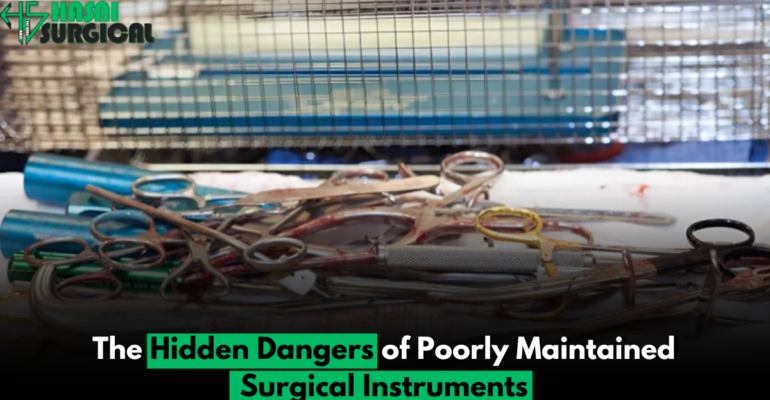Poorly Maintained Surgical Instruments and Its 5 Hidden Dangers
January 10, 2025 2025-01-13 10:41Poorly Maintained Surgical Instruments and Its 5 Hidden Dangers

Poorly Maintained Surgical Instruments and Its 5 Hidden Dangers
In healthcare, surgical instruments are the unsung heroes, performing critical roles in diagnosing and treating patients. Yet, the importance of maintaining these tools often goes unnoticed until something goes wrong. Poorly maintained surgical instruments can pose serious health risks, leading to infections, complications, and even fatalities. In this blog, we will explore the hidden dangers of neglected surgical instruments and emphasize the importance of proper maintenance for ensuring patient safety and successful medical outcomes.
Why Surgical Instrument Maintenance Matters
Surgical instruments are designed to be precise and effective. Whether it’s a scalpel, forceps, or clamps, these tools must be clean, sterile, and in optimal condition to perform their functions. Any deviation from these standards can compromise a surgery’s success.
Neglecting proper maintenance can result in dull blades, rusted surfaces, or, worse, the presence of harmful microorganisms. This not only jeopardizes the patient’s health but also tarnishes the trust patients place in healthcare providers.

The Hidden Dangers of Poorly Maintained Surgical Instruments
1. Increased Risk of Surgical Site Infections (SSIs)
Surgical site infections (SSIs) are one of the most common complications arising from improperly maintained instruments. Contaminated tools can introduce bacteria like Staphylococcus aureus or Escherichia coli into surgical wounds, causing severe infections. According to the Centers for Disease Control and Prevention (CDC), SSIs account for up to 20% of hospital-acquired infections.
These infections can delay recovery, require additional surgeries, and increase healthcare costs significantly. In severe cases, SSIs can lead to sepsis, a life-threatening condition.
2. Cross-Contamination
Poor sterilization practices can lead to cross-contamination, where pathogens are transferred between patients via surgical instruments. Diseases like hepatitis B, hepatitis C, and HIV can be transmitted this way, turning a routine procedure into a public health crisis.
3. Compromised Instrument Performance
Dull scalpels, bent forceps, or poorly aligned scissors can lead to surgical errors. Inaccurate incisions or difficulty in handling tissue can prolong procedures, increase blood loss, and heighten the risk of complications. Moreover, compromised tools can cause unnecessary trauma to the patient’s body, delaying the healing process.
4. Foreign Material Contamination
Rust, biofilm, or residue from cleaning agents on surgical tools can contaminate the surgical site. These foreign materials can cause allergic reactions, chronic inflammation, or non-healing wounds, putting patients at significant risk.
5. Legal and Financial Repercussions
Neglecting proper maintenance of surgical instruments can lead to lawsuits, financial losses, and reputational damage for healthcare facilities. Patients harmed by unclean or defective tools have the right to seek legal recourse, which can result in hefty penalties for the institution.

Causes of Poor Instrument Maintenance
- Inadequate Cleaning Protocols: Failing to follow standardized cleaning procedures can leave behind organic material, blood, or tissue on instruments, creating a breeding ground for bacteria.
- Improper Storage: Storing instruments in damp or unclean environments can lead to corrosion and microbial growth.
- Lack of Regular Inspection: Instruments need to be routinely checked for wear and tear. Cracks, rust, or loose joints can harbor bacteria and compromise tool performance.
- Human error: Overworked or undertrained staff may overlook proper sterilization or handling techniques.
- Outdated Equipment: Using old or damaged sterilization machines can render cleaning efforts ineffective.

Best Practices for Surgical Instrument Maintenance
1. Follow Proper Cleaning Steps
The cleaning process begins immediately after a procedure. Instruments should be rinsed with cold water to remove blood and debris, followed by thorough cleaning with a neutral-pH detergent. Ultrasonic cleaners are highly effective for removing microscopic debris from hard-to-reach areas.
2. Sterilization Standards
Autoclaving is the gold standard for sterilization, using high-pressure steam to kill bacteria, viruses, and spores. For heat-sensitive instruments, chemical sterilizants or low-temperature sterilization methods should be employed.
3. Routine Inspections
Regular inspections are crucial to identify signs of damage, such as corrosion, loose screws, or dull edges. Defective tools should be repaired or replaced promptly.
4. Proper Storage
Instruments must be stored in dry, clean, and temperature-controlled environments to prevent rust and contamination. Using trays or racks ensures that tools remain organized and protected from physical damage.
5. Staff Training
Healthcare workers involved in cleaning and handling surgical instruments must be trained in proper sterilization techniques, maintenance protocols, and safety measures.
Case Studies: The Consequences of Neglect
Case 1: Outbreak in a Surgical Ward
A hospital in the United States faced a lawsuit after a series of infections were traced back to improperly sterilized surgical instruments. The root cause was identified as a malfunctioning autoclave, which had not been serviced for years. Over a dozen patients suffered complications, highlighting the need for regular equipment maintenance.
Case 2: A Costly Oversight
In the UK, a patient developed sepsis after undergoing a routine appendectomy. Investigations revealed traces of biofilm on a pair of forceps used during the procedure. The hospital incurred significant legal and reputational costs as a result of this oversight.

Benefits of Proper Maintenance
Investing time and resources in maintaining surgical instruments yields numerous benefits:
- Enhanced Patient Safety: Reducing the risk of infections and complications ensures better recovery outcomes.
- Operational Efficiency: Well-maintained tools perform effectively, reducing surgical times and minimizing errors.
- Cost Savings: Preventing infections and avoiding legal claims can save healthcare facilities significant amounts of money.
- Compliance with Standards: Proper maintenance helps facilities meet regulatory requirements and accreditation standards.
Conclusion
The hidden dangers of poorly maintained surgical instruments cannot be overstated. From life-threatening infections to legal repercussions, the consequences of neglecting these tools can be severe. Healthcare providers must prioritize the proper cleaning, sterilization, and storage of surgical instruments to safeguard patient health and ensure successful medical outcomes.
Ultimately, surgical instruments are more than just tools—they are lifelines. By maintaining them properly, we uphold the trust patients place in healthcare systems and pave the way for safer, more effective treatments.
